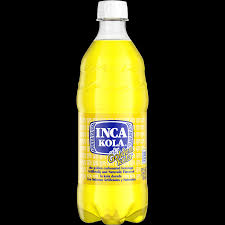Inca Kola: The Golden Elixir of Peru also known as “The Golden Kola,” is a popular soft drink in Peru and a source of pride for Peruvians and foodies. The cultural importance and possible health benefits of Inca Kola are just two of the many intriguing topics we’ll cover in this essay.
The Incas and the Kola Nut
Inca Kola’s history stretches back to 1935 when José R. Lindley, a British immigrant to Peru, introduced the world to this unique beverage. Inspired by the Inca culture’s devotion to the golden colour, Lindley created Inca Kola, a bright yellow drink that immediately became a national icon. Learn how this drink went from being a novelty to a source of national pride in Peru.
Inca Kola’s Components
The key to Inca Kola’s unique flavour rests in its closely guarded recipe. In this article, we’ll investigate what makes Inca Kola so unique. Every sip is an adventure in taste, from the bright citrus top notes to the delicate herbal bottom notes.
Inca Kola’s Distinct Flavor
Can you describe the flavour of Inca Kola? It is challenging to put into words the colourful, exotic taste of this drink, but we’ll do our best by diving into the sensory experience. You’ll find out why many compare Inca Kola to molten gold.
Inca Kola Versus Other Soft Drinks
We’ll discuss how Inca Kola differs from standard soft drinks like Coke and Pepsi to show its uniqueness. Learn what makes Inca Kola unique regarding flavour, ingredients, and cultural significance.
The Global Spread of Inca Kola
Although Inca Kola has roots in Peru, it has become popular worldwide. We’ll investigate where you can discover this Peruvian treasure and how many cultures and groups have welcomed it.
Inca Kola and Its Cultural Importance
Inca Kola isn’t just a beverage; it’s a symbol of Peruvian culture and identity. Please find out how it has become a part of Peruvian culture and how it is celebrated and incorporated into everyday life.
Promotion and Naming of Inca Kola
The advertising campaigns for Inca Kola have always been exciting and unique. Some of the most memorable commercials and the brand’s original promotional strategy will be dissected here.
Inca Kola can be used as more than just a refreshing beverage; it also has culinary applications. We’ll give you some unique and tasty ideas for using Inca Kola in your cooking.
The Inca Kola Health Benefits
It’s essential to drink soft drinks in moderation, but Inca Kola may have some positive health effects. We will talk about its medicinal and nutritional uses and benefits.
Is there no gluten in Inca kola?
Knowing whether or not Inca Kola contains gluten is vital for those who have sensitivity to or allergies to the protein. We’ll address this prevalent dietary worry head-on.
Peruvian Food and Inca Cola
Inca Kola is more than just a refreshing drink; it plays a crucial role in traditional Peruvian cooking. We’ll go into how it may elevate the flavour of classic recipes and make for a more memorable meal.
Items Featuring Inca Cola
Products based on the Inca Kola have increased because of its widespread appeal. We’ll check out how fans of this one-of-a-kind soda can show their support, from t-shirts to mugs.
Conclusion
Inca Kola, the dazzling expression of Peruvian culture, is more than simply a soft drink; it’s a symbol of heritage, innovation, and the vivid spirit of Peru. Its golden elixir grabs the hearts and palates of people who drink it because of its unique flavour and storied past.
Questions That Were Asked Often
Can you get drunk from Inca Kola?
No, Inca Kola is a non-alcoholic carbonated soft drink.
Can I get Inca Kola elsewhere else but Peru?
Many grocery stores and websites sell Inca Kola around the world.
What does the golden hue of Inca Kola represent?
The Incas, for whom gold was paramount, inspired the hue yellow.
Can you get Inca Kola in multiple flavours?
Although the original yellow Inca Kola is the most common, other tastes, such as lemon and pineapple, have gained popularity in recent years.
Does caffeine exist in Inca Kola?
Inca Kola, like many other standard soft drinks, does contain caffeine.




